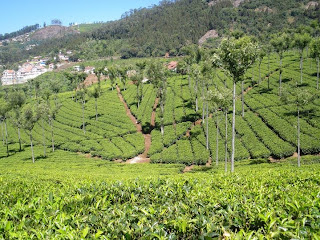We were able to drive through a Nilgiri village and catch the beautiful view of the mountains while returning from Pykara waterfalls. Thanks to the traffic jam by the factory workers of "Hindustan Foto Films" (the non digital camera world would remember this name as this factory manufactures the famous brand "Indu" photo films) as this made us take a detour through the village to reach Ooty.
Friday, February 4, 2011
Thursday, February 3, 2011
Toda Village
Todas are one of the most ancient tribes of the world. They live in the Nilgiris of Tamilnadu. About 1100 in number, they have their own unique customs and language. Their homes have an igloo like structure with a door at the base and no windows. Five such huts make a "mund" (village).

I liked the white, red and black embroidery handicrafts made by the toda tribal women but was unable to find the design I was looking for. May be some other time. Will check out at the Tamilnadu State Emporium at Delhi.
I was amazed to learn that John Sullivan, the Coimbatore Collector bought Ooty from the Todas for just one rupee in the year 1823. John Sullivan liked the place so much that he developed it into a town and called it Ootacamund.
Wednesday, February 2, 2011
Tuesday, February 1, 2011
Coonoor Travelogue
We are currently visiting the "Western Ghats". We took a trip from Ooty to Coonoor today. This is just a 19 kilometres distance. On our way we saw the World War II Memorial at Wellington. Then went to SIMS park and a tea factory. This tea factory is 100 yrs old. They make a reputed export brand "High Field Tea" which they export to Canada, Europe and USA. They made us sample variety of teas to help us choose buy tea. Our cab driver showed us the Toy Train that runs from Ooty to Coonoor. This is the train on which the famous "chaiyya chaiyya" song was shot for a hindi movie. It sure was a great experience at Coonoor. The tea gardens looked so spectacular. Silver Oak trees are planted in the tea gardens to absorb excess water and moisture in the soil. I liked the silver leaves of these trees. The tea factory was in operation and we saw how the tea leaves are dried in weathering troughs, then cut, rolled and curled and roasted to make the tea that we enjoy every day.
Subscribe to:
Comments (Atom)












